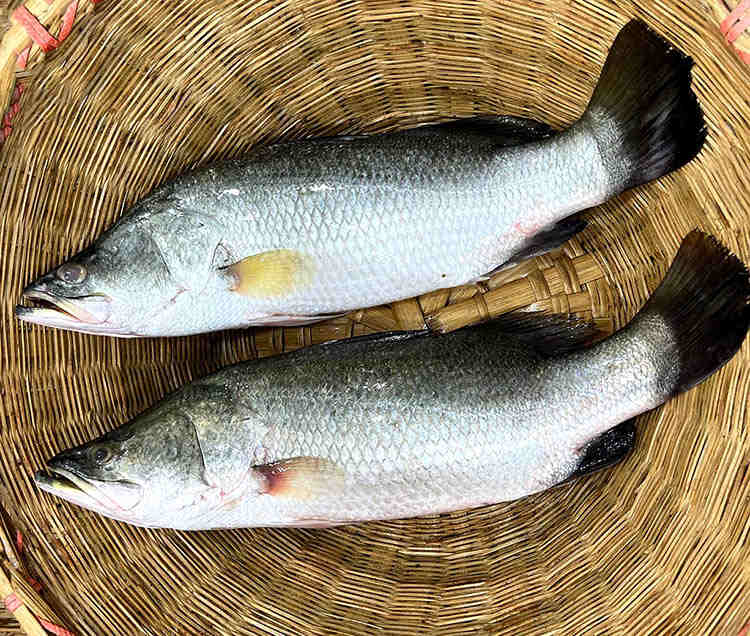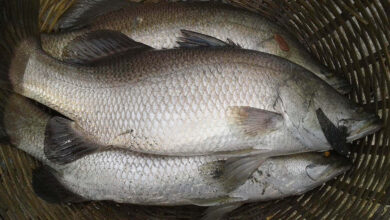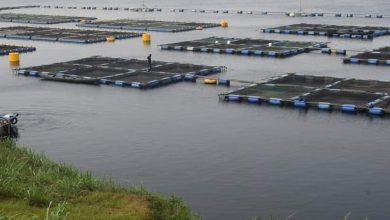
The cultivation of Asian Seabass (Lates calcarifer), greenback mullet (Chelon subviridis), nona tengra (Mystus gulio), seaweed, oysters, and green mussels as a form of mariculture has tremendous potential in Bangladesh’s coastal districts. Coastal farmers have been trying to raise expensive seabass in ponds or other enclosed areas, even though mariculture has not been used to cultivate these commercially important species.
While institutions connected to extension are aiming to increase seabass culture, other organizations in Bangladesh, particularly scientific institutions, are focused on producing seabass fries artificially. Bangladesh Fisheries Research Institute (BFRI) also started an experimental project on coral fish farming in cages in the Andharmanik river in Patuakhali’s Kalapara upazila. Initiatives are being conducted by the Palli Karma-Sahayak Foundation (PKSF)’s fisheries division to reach out to impoverished farmers in isolated coastal districts with high-value seabass cultivation. Programs including field days, carp and seabass farming demos, training, billboard installation, market linkage workshops, farmer-motivation tours, and the establishment of local seabass marketing centers and depots are all being carried out as part of the plan.
Culture Techniques:
Seabass has been farmed in Bangladesh’s coastal regions using a traditional and semi-intensive method that involves seedlings stocked in natural resources. Few nurseries in Bangladesh produce fingerlings from naturally occurring eggs and fry. The primary issue here, though, is that the seabass has not acclimated to additional commercial fish feed in culture ponds, forcing the farmer to employ live feed in the form of silver carp or tilapia fish fries.
The nursing stage:
The tide water then carries the eggs and larvae to the estuary following ovulation. The larvae migrate from the estuary to the upper reaches of the river, where they are caught by local fishermen. Larvae placed in ponds have a very high probability of dying. Rather, one of two methods is used to develop larvae from natural sources to produce juveniles that are up to three to five inches in length.
In nursery tanks or ponds, fries with a length of 0.5 to 1.0 inches are stocked at a density of 800-1100 per cubic meter and fed moderate amounts of nursery feed. A lot of people are also used to consuming shrimp and fish flesh, particularly those who will eventually farm naturally with little to no live food. Every three to four days, the bigger fries are chosen and separated, and while the seabass consume the smaller fish, the same-sized fry are raised in the tank using the grading process. Approximately one-third of the water in the nursing tank is changed each day.
The water in the tank is kept at a semi-brackish level, about 10 parts per thousand. Once the fish have been raised in the tanks for 30 to 40 days, the typical size of the fish that are retrieved for stocking ponds is between 3 and 5 inches, with a survival rate of 70–80%.
Grow-out Stage:
1. Pond Preparation:
Pond renovations are started by seabass growers in February and March. Generally, the pond is prepared by clearing it of all fish, letting it dry out, and adding lime. When the pond is ready, the producers get in touch with the fry providers to order seabass fish fries.
- Optimum water quality parameter:
Standard water quality parameter should be Temperature: 26–32°C, Salinity: 10–30 ppt, Dissolved oxygen: 4–9 ppm, pH: 7.5–8.5, Turbidity: less than 10 ppm, H2S: less than 0.3 ppm, NH3: less than 1 ppm. Regularly, water quality parameter monitoring is necessary.
The amount of clay in a site is crucial because it prevents acid-sulfate soil and can retain water. Prior to stocking, an inorganic fertilizer can be used and an organic manure application of up to 2000 kg per hectare can be made.
3. Stocking density:
In mixed aquaculture, tiny fish species, carp, tilapia, and seabass are all raised together. These farmers’ farms range in size from 15 to 40 decimal places. Typically, 5 kg of tilapia fish fries of the same size are stored in storage at the same time as 25–35 pieces of seabass fry, measuring 1.5–3.0 inches in size, are stocked each decimal. Small tilapia and zooplankton are the main sources of food for seabass; later, larger tilapia and carp fish fry. Fresh tilapia fish fries are discharged when the population of tilapia declines, and eels and rubbish fish are frequently fed. In this instance, feeding seabass with 5 kg of carp or tilapia fish fry per decimal every month produces good outcomes. Seabass gains 2-3 kg with this procedure and reaches a salable weight in a year.
4. Feed Management:
As it stands, waste fish is the only additional feed source for seabass culture. 10% to 5% of the total biomass might be applied to ground or chopped trash fish. After the first feeding, the application of feeding might continue for up to ninety days. It is recommended to feed them twice a day. A 1.5 kg/day/100 fish application of chopped fish is possible, although. In this instance, feeding seabass with 5 kg of carp or tilapia fish fry per decimal every month produces good outcomes. Seabass gains 2-3 kg with this procedure and reaches a salable weight in a year.
5. Monitoring:
Frequent water exchange through the entrance is crucial for maintaining the proper salinity of the water needed for seabass culture as well as a healthy aquatic habitat. It is necessary to regularly check or inspect the area for pests and predators like crabs and water snakes. Waterfowl should be removed using a soft brush, and parasites should be removed as well. To prevent more pollution of the water, dead fish should be removed from the pond.
6. Marketing:
Seabass prices are largely determined by weight on the market, just like the prices of most other fish. Fish that are larger in size tend to cost more per kilogram.
Bangladesh offers enormous potential for mariculture due to its large coastal water bodies and ideal climate. Either in ponds or cages, seabass culture has the potential to advance mariculture and strengthen the economy.
Farhana Islam
Agriculturist, Researcher
Fisheries Resource Management, CVASU


